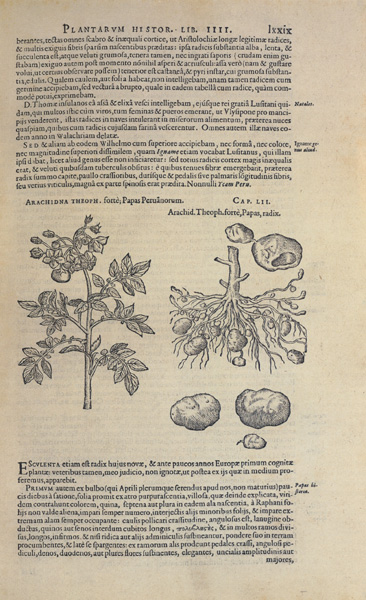
The first description of the potato in English appears in The Herball or Generall Historie of Plantes (1597) by John Gerard (1545-1612), who corresponded with Clusius and provided him with some tubers, presumably from his own garden. Gerard mistakenly thought the white potato to be native to America, calling it the "Virginian Potato" (II.146) to distinguish it from the red sweet potato (II.145), which he calls simply "Potato."
The book, itself, has a curious history. It is dedicated to William Cecil, Lord Burghley, whose gardens Gerard had supervised. Robert Priest, a member of the London College of Physicians, was commissioned to translate Rembert Dodoens' collected works Stirpium Historiae Pemptades Sex (1583) into English, but he died before the book was published. Gerard, who had cataloged his own extensive garden the year before (the first complete inventory of a private garden) was called upon to complete the project. With the death of Priest, however, as Gerard shamelessly professes to the reader, "his translation likewise perished" and he appropriated it as "the first fruits of these myne owne Labours."
Gerard also changed how the plants were arranged, ordering them according to the Stirpium Adversaria Nova (1570) of Mathias Lobel (de l'Obel, Latinized as Lobelius), whose classification was based on the characteristic differences of leaf structure. There are eighteen hundred woodcuts in the Herball, almost all of them (the woodcut of the potato, which is the first to represent the plant, being an important exception) taken from the Eicones plantarum (1590) of Jacobus Theodorus, which themselves been reproduced from earlier herbalists such as Mattioli, Dodoens, Clusius, and Lobel. But Gerard was not sufficiently knowledgeable to match all the plant descriptions with their proper illustrations. Lobel, who was living in England, was asked to correct the errors and claimed to have discovered over a thousand. But a perturbed Gerard cut short the work, complaining that Lobel did not known enough English, and the Herball went to press as it was—the final third being less reliable than it could have been.
A second edition was published in 1633, enlarged and amended by Thomas Johnson, who dismissed Gerard with the introductory comment that "His chiefe commendation is that he out of a propense goodwill to the publique advancement of this knowledge, endeavoured to performe therein more than he could well accomplish; which was partly through want of sufficient learning." Essentially unchanged, the Herball was published again in 1636.
Its charm is a recall of the Elizabethan countryside and the medical properties ("vertues") of the plants, themselves. Here Gerard discusses the tulip, "a strange and forrein floure." "Each new yeare bringeth forth new plants of sundry colours not before seen; all which to describe particularly were to rolle Sisiphus stone, or number the sands....Nature seems to play more with this floure than with any other that I do know" (I.18).
Gerard is even more enamored of English violets, which
"have a great prerogative above others, not only because the mind conceiveth a certain pleasure and recreation by smelling and handling those most odoriferous floures, but also for that very many by these violets receive ornament and comely grace; for there be made of them garlands for the head, nosegaies and poesies, which are delightfull to looke on and pleasant to smel to, speaking nothing of their appropriat vertues; yea gardens themselves receive by these the greatest ornament of all, chiefest beauty, and most excellent grace, and the recreation of the minde which is taken hereby cannot be but very good and honest; for they admonish and stirre up a man to that which is comely and honest; for floures through their beauty, varietyof colour, add exquisit forme, do bring to a liberall and gentle manly minde, the remembrance of honestie, comlinesse, and all kindes of vertues: for it would be an unseemly and filthy thing (as a certain wise man saith) for him that doth looke upon and handle faire and beautiful things, to have his mind not faire, but filthy and deformed" (II.133).
The woodcut is from Clusius' Rariorum plantarum historia (1601), a description of rare and exotic plants, including the potato, which Sir Francis Drake had brought from the New World to England in 1586 and planted there. The earliest watercolor painting of a flowering potato plant is dated 1588, when Clusius was sent two tubers. The following year, he received the picture itself. As Europe's most renown botanist, there must have been some consternation at not having been informed sooner about a plant so common by then that it was being fed to pigs.
References: Ein Garten Eden (2001) by H. Walter Lack and translated by Martin Walters; Gerard's Herball (1927) edited by Marcus Woodward (a selected reprint of the 1636 edition); Herbals: Their Origin and Evolution (1953) by Agnes Arber. See also Potato: A History of the Propitious Esculent (2008) by John Reader.